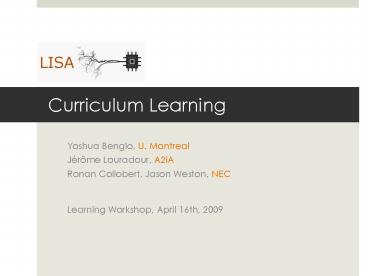Curriculum Learning PowerPoint PPT Presentation
1 / 24
Title: Curriculum Learning
1
Curriculum Learning
- Yoshua Bengio, U. Montreal
- Jérôme Louradour, A2iA
- Ronan Collobert, Jason Weston, NEC
- Learning Workshop, April 16th, 2009
2
Curriculum Learning
- Guided learning helps training humans and animals
- Shaping
- Education
Start from simpler examples / easier tasks
(Piaget 1952, Skinner 1958)
3
The dogma in question
- It is best to learn from a training set of
examples sampled from the same distribution as
the test set. Really?
4
Question
- Can machine learning algorithms benefit from a
curriculum strategy?
(Elman 1993) vs (Rohde Plaut 1999)
5
Convex vs Non-Convex Criteria
- Convex criteria the order of presentation of
examples should not matter to the convergence
point, but could influence convergence speed - Non-convex criteria the order and selection of
examples could yield to a better local minima - humans raised without any human guidance
(wild children) are much less operationally
intelligent
- else
6
Deep Architectures
- Theoretical arguments deep architectures can be
exponentially more compact that shallow ones
representing the same function - Many local minima
- Guiding the optimization by unsupervised
pre-training yields much better local minima o/w
not reachable - Good candidate for testing curriculum ideas
7
Deep Training Trajectories
- (Erhan et al. AISTATS 09)
- Random initialization
- Unsupervised guidance
8
Starting from Easy Examples
- Sequence of training distributions
- Initially peaking on easier / simpler ones
- Gradually give more weight to more difficult ones
until reach target distribution
9
Continuation Methods
10
Curriculum Learning
- See ICML2009 paper
- Sequence of training distributions
- Initially peaking on easier / simpler ones
- Gradually give more weight to more difficult ones
until reach target distribution
11
How to order examples?
- The right order is not known
- Toy experiments with simple order
- Larger margin first
- Less noisy inputs first
- Simpler shapes first, more varied ones later
- Smaller vocabulary first
12
Larger Margin First Faster Convergence
13
Cleaner First Faster Convergence
14
Shape Recognition
First easier, basic shapes
Second target more varied geometric shapes
15
Shape Recognition Experiment
- 3-hidden layers deep net known to involve local
minima (unsupervised pre-training finds much
better solutions) - 10 000 training / 5 000 validation / 5 000 test
examples - Procedure
- Train for k epochs on the easier shapes
- Switch to target training set (more variations)
16
Shape Recognition Results
k
17
Language Modeling Experiment
- Objective compute the score of the next word
given the previous ones (ranking criterion) - Architecture of the deep neural network
- (Bengio et al. 2001, Collobert Weston 2008)
18
Language Modeling Results
- Gradually increase the vocabulary size (dips)
- Train on Wikipedia with sentences containing only
words in vocabulary
19
Conclusion
- Yes, machine learning algorithms can benefit from
a curriculum strategy.
20
Why?
- Faster convergence to a minimum
- Wasting less time with noisy or harder to predict
examples - Convergence to better local minima
- Curriculum particular continuation
method - Finds better local minima of a non-convex
training criterion - Like a regularizer, with main effect on test set
21
Perspectives
- How could we define better curriculum strategies?
- We should try to understand general principles
that make some curricula work better than others - Emphasizing harder examples and riding on the
frontier
22
Training Criterion Ranking Words
23
Curriculum Continuation Method?
- Examples from are weighted by
- Sequence of distributions
called a curriculum if - the entropy of these distributions increases
(larger domain) - monotonically increasing in ?
24
Riding the Frontier
- Spending half the time on examples whose
likelihood is worse than some threshold converges
much faster on MNIST
- Error
Mean difficulty of ex. seen
- Training Time
- Training Time

